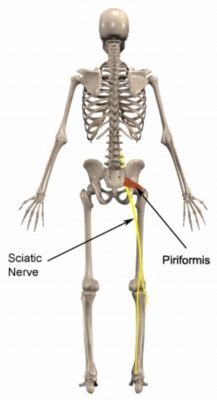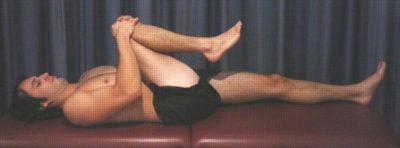Piriformis Syndrome
Updated:
(Also known as Piriformis Muscle Syndrome, Piriformis Dysfunction, Piriformis Impingement, Piriformis Muscle Strain)
What is piriformis syndrome?
Piriformis syndrome is a relatively uncommon cause of buttock pain and sciatica. The piriformis muscle lies deep within the buttock originating from the sacrum (tail bone) and attaching to the femur (thigh bone) (figure 1).

The piriformis muscle is responsible for rotating and stabilizing the hip joint. The sciatic nerve passes directly beneath or occasionally through the piriformis muscle (figure 1). Due to this anatomic relationship, the sciatic nerve can be compressed due to tightness in the piriformis muscle or following a piriformis strain. When this occurs the condition is known as piriformis syndrome.
Causes of piriformis syndrome
Piriformis syndrome typically occurs due to tightness of the piriformis muscle. This may occur following piriformis injury, overuse of the piriformis, injury to the lumbar spine or due to repetitive strain or trauma. Piriformis syndrome is more common in sports or activities requiring repeated use of the piriformis muscle. These activities may include: running (especially changing direction), sprinting, jumping, squatting or lunging.
Signs and symptoms of piriformis syndrome
Patients with this condition typically experience a pain or ache that is felt deep within the buttock. Pain may also radiate into the back of the thigh, calf, ankle or foot. Patients with piriformis syndrome typically experience an increase in pain when placing the piriformis muscle on stretch (i.e. taking your knee towards your opposite shoulder) or during forceful piriformis muscle contraction (e.g. when running and changing directions). Other activities that may aggravate symptoms include: sitting, climbing stairs, squatting and lunging. In addition, patients may also have reduced hip range of movement and experience tenderness in the piriformis muscle on firm palpation.
Diagnosis of piriformis syndrome
A thorough subjective and objective examination from a physiotherapist is usually sufficient to diagnose piriformis syndrome. Occasionally, further investigations such as an MRI scan or Ultrasound may be required, to assist diagnosis.
Treatment for piriformis syndrome

Members Only ContentBecome a PhysioAdvisor Member to gain full access to this exclusive content. For more details see Become a Member. Already a member? Login Now
Prognosis of piriformis syndrome
With early diagnosis and appropriate management, most patients with this condition can usually recover in days to weeks. In severe or chronic cases of piriformis syndrome, recovery may take significantly longer.
Contributing factors to the development of piriformis syndrome
There are several factors which can predispose patients to developing this condition. These need to be assessed and corrected with direction from a physiotherapist. Some of these factors include:
- muscle tightness (particularly the piriformis and adductor muscles)
- joint stiffness (particularly the hip, lower back, sacroiliac joints or pelvic joints)
- muscle weakness (particularly the piriformis and gluteals)
- lower back injury
- poor posture
- excessive or inappropriate training
- poor biomechanics
- inadequate warm up
- poor pelvic or core stability
- muscle imbalances
Physiotherapy for piriformis syndrome
Physiotherapy for patients with this condition is vital to hasten the healing process, ensure an optimal outcome and reduce the likelihood of injury recurrence. Treatment may comprise:
- soft tissue massage
- electrotherapy (e.g. ultrasound)
- stretches
- dry needling
- muscle energy techniques
- joint mobilization
- neural mobilization
- ice or heat treatment
- education
- biomechanical correction
- progressive exercises to improve strength, flexibility and core stability
- activity modification advice
- technique correction
- devising and monitoring a return to sport or activity plan
Other intervention for piriformis syndrome
Despite appropriate physiotherapy management, some patients with this condition do not improve adequately. When this occurs, the treating physiotherapist or doctor can advise on the best course of management. This may include investigations such as an ultrasound, CT scan or MRI, pharmaceutical intervention, corticosteroid injection, or referral to appropriate medical authorities who can advise on any intervention that may be appropriate to improve the condition. In very rare cases of severe or recalcitrant piriformis syndrome, surgical intervention may be considered.
Exercises for piriformis syndrome
The following exercises are commonly prescribed to patients with this condition. You should discuss the suitability of these exercises with your physiotherapist prior to beginning them. Generally, they should be performed 2 – 3 times daily and only provided they do not cause or increase symptoms.
Your physiotherapist can advise when it is appropriate to begin the initial exercise and eventually progress to the intermediate and advanced exercises. As a general rule, addition of exercises or progression to more advanced exercises should take place provided there is no increase in symptoms.
Initial Exercise
Piriformis Stretch Supine
Begin lying on your back (figure 2). Using your hands, take your knee towards your opposite shoulder until you feel a stretch in the buttocks or front of your hip. Hold for 15 seconds and repeat 4 times at a mild to moderate stretch provided the exercises is pain free.

Intermediate Exercises

Members Only ContentBecome a PhysioAdvisor Member to gain full access to this exclusive content. For more details see Become a Member. Already a member? Login Now
Advanced Exercises

Members Only ContentBecome a PhysioAdvisor Member to gain full access to this exclusive content. For more details see Become a Member. Already a member? Login Now
Rehabilitation protocol for piriformis syndrome

Members Only ContentBecome a PhysioAdvisor Member to gain full access to this exclusive content. For more details see Become a Member. Already a member? Login Now
 Physiotherapy products for piriformis syndrome
Physiotherapy products for piriformis syndrome
Some of the most commonly recommended products by physiotherapists to hasten healing and speed recovery in patients with this condition include:
To purchase physiotherapy products for this condition click on one of the above links or visit the PhysioAdvisor Shop.
 Find a Physio
Find a Physio
Find a physiotherapist in your local area who can treat this condition.
 More Information
More Information
- Gluteal Stretches.
- Gluteal Strengthening Exercises.
- Core Stability Exercises.
- How to use Crutches.
- R.I.C.E. Regime.
- Ice or Heat.
- Why is my injury not improving?
- View a Return to Running Program that is often used in rehabilitation.
- View our Buttock Pain Diagnosis Guide.
Become a PhysioAdvisor Member
-
 Individual Membership (12 Months)$59.95 for 1 year
Individual Membership (12 Months)$59.95 for 1 year -
 Individual Membership (3 Months)$39.95 for 3 months
Individual Membership (3 Months)$39.95 for 3 months -
 Individual Membership (Yearly)$49.95 / year
Individual Membership (Yearly)$49.95 / year -
 Individual Membership (Monthly)$15.95 / month
Individual Membership (Monthly)$15.95 / month

Link to this Page
If you would like to link to this article on your website, simply copy the code below and add it to your page:
<a href="https://physioadvisor.com.au/injuries/buttock/piriformis-syndrome”>Piriformis Syndrome – PhysioAdvisor.com</a><br/>Piriformis syndrome is a relatively uncommon cause of buttock pain and sciatica. Get complete information about piriformis syndrome at Physioadvisor.com.au.
Return to the top of Piriformis Syndrome.







